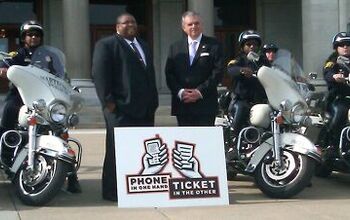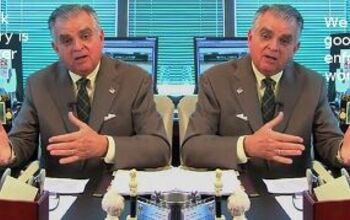Ray LaHood's Opt-In War On Distracted Driving
Poor Ray LaHood. Having endured considerable embarrassment over his department’s handling of the Toyota Unintended Acceleration recall, all the Secretary of Transportation seems to want to do is talk about the “epidemic” of distracted driving. But, as TTAC has continually reminded, changing driver behaviors is a notoriously tricky task. The government’s choice: mandate intrusive measures like in-car cell phone blocking or continual surveillance of all vehicles, or go for voluntary “cures” that don’t even begin to address the underlying problem of increased driver distraction. And despite repeatedly referring to distracted driving in epidemiological terms, LaHood seems to prefer the “it’s actually your problem” approach, telling automakers [via AN [sub]]that NHTSA will
issue voluntary standards to handle the dangers of the connected car… in the third quarter of 2011.
Which means that nothing meaningful will ever actually be done about distracted driving. After all, the automakers contend that drivers will use cell phones in cars “no matter what,” and that in-car connectivity systems simply make the inevitable sin less dangerous. Of course, the evidence doesn’t seem to back up that position, as an IIHS survey shows no significant difference in safety after a hands-free cell phone ban. But, because the industry is under intense pressure to deliver profits from new connectivity systems, the logic that more systems will make drivers more likely to unsafely use phones in their cars is simply being ignored. And though the voluntary approach is better than intrusive government-mandated workarounds, is still nowhere close to living up to LaHood’s overblown rhetoric.
Automotive News [sub] offers the following taste of already in-place measures from automakers aimed at reducing distracted driving (or, at least making money).
‘I’m driving right now’Who: OnStar
What: OnStar is testing an application to bring Facebook into the car. Facebook and standard text messages are received by a driver’s smart phone and relayed wirelessly to the car and its speakers. Before getting behind the wheel, a driver can set his smart phone to block messages and send a message to senders: “I am driving right now and cannot reply.”
How it limits distraction: Drivers are unaware of incoming messages, which are stored.
Listen to Facebook posts Who: Harman InternationalWhat: Stereo maker Harman is pitching to automakers Aha Radio, which beams Internet signals from a driver’s cell phone to a car’s center console. The system reads Facebook messages to drivers with text-to-speech technology.
How it limits distraction: Drivers hear messages and don’t use hands and eyes to operate their Internet-connected smart phones.
Use the center consoleWho: , Nokia Corp.
What: Internet applications, such as navigation and Internet radio, are received on a smart phone and beamed wirelessly to the center console or a screen in front of the passenger. Continental says it is discussing the technology with potential customers.
How it limits distraction: Drivers can, for example, switch radio stations on the center console easier than on a smart phone.
Disable the cell phoneWho: T-Mobile USA
What: For $4.99 a month, cell phone company
T-Mobile disables most texting and calling features to certain cell phones in a moving car.
How it limits distraction: No text or call, no distraction.
Hands off that cell phoneWho:
What: Sync, Ford’s infotainment system, reads text messages out loud to drivers. The texts are received by cell phones and relayed to Sync.
How it limits distraction: Hearing a text message is safer than using eyes and hands to operate a cell phone while driving.
Listen to texts laterWho:
What: By pushing a “Do not disturb” button on four vehicles, drivers send incoming cell calls to voicemail and texts to storage. The feature is available on the 2011 , and and the 2012 Focus with Sync and MyFord Touch or MyLincoln Touch.
How it limits distraction: The driver is not interrupted. The voicemails can be heard and texts can be read later.
Pull over to browse the WebWho:
What: Toyota prevents drivers from using some Internet features that are too distracting. For example, with the Entune application, drivers can conduct only Internet searches relevant to driving, such as for gasoline stations. Other searches must be conducted when the car is parked.
How it limits distraction: Searching while parked is safe.
Eyes straight aheadWho: Denso International
What: A head-up system displays information in front of the driver on the windshield. An undisclosed automaker will introduce Denso’s system in North America.
How it limits distraction: The motorist won’t have to glance down at a console or a cell phone. Eyes remain on the road.
Less strain on the brainWho:
What: Drivers use natural speech, such as “Find local gasoline stations,” to conduct Internet searches. They don’t need to memorize a tree of voice commands, such as “retail” and “gasoline stations.” The searches are conducted by a smart phone wirelessly connected to the car’s center console with an application called Entune, which will be available first on the V this summer.
How it limits distraction: Natural speech reduces mental strain, allowing drivers to concentrate on the road.
Notice that the only actual non-voluntary, actually effective method for keeping drivers off their cell phones comes not from an OEM or auomotive supplier… but Nokia, a cell phone company. Everyone else in the industry has a major incentive in selling in-car cell phone solutions that make it easier to use phones while driving, rather than sending the message that in-car phone use is fundamentally dangerous… at least until the personal-injury lawsuits against automakers offering in-car connectivity systems start. Only then will we see automakers moving in line with the rhetoric that Ray LaHood can’t seem to live up to.More by Edward Niedermeyer
Latest Car Reviews
Read moreLatest Product Reviews
Read moreRecent Comments
- Ajla Both parties are in favor of banning Chinese vehicles so I don't see how it won't happen in the next year.
- Add Lightness I don't waste a lot of time watching nothing much happening by watching the YouTube 6 minute highlights.
- MrIcky from my rental fleet experience, id rather drive one of these than a camry.
- Add Lightness Protectionist fear competition under the guise of paranoia.
- Kjhkjlhkjhkljh kljhjkhjklhkjh But facebook, instagram, twitter, your cell phone, your chevy/ford/dodge, your debit card, your credit card selling your data to the SAME OVERSEAS DATABROKERS is ok.Meanwhile parler, telegram literally run on russian hardware is also ''ok''


































Comments
Join the conversation
While it won't put an end to distracted driving (nothing will) there's a very simple method to minimize it. Do away with automatic transmissions. Manuals only. And crush all the current cars with automatics. It's a lot harder to text when you're actually having to pay attention to your driving, or risk a stall (at least) in traffic.
It's funny what yr kids remember about you. My daughter remembers getting her driver's license and especially how I disabled the stereo in her car with the promise I'd hook it up in two months IF she got no tickets and no wrecks. Now she laughs about it. Then she didn't think it was so damn funny. But now I see young drivers on the cellie, texting etc, and they're overconfident and inattentive drivers to begin with. The adults are only marginally better, possibly because most adults don't like/want to gab on the steenkin phone. If you need to talk on the phone, pull over.